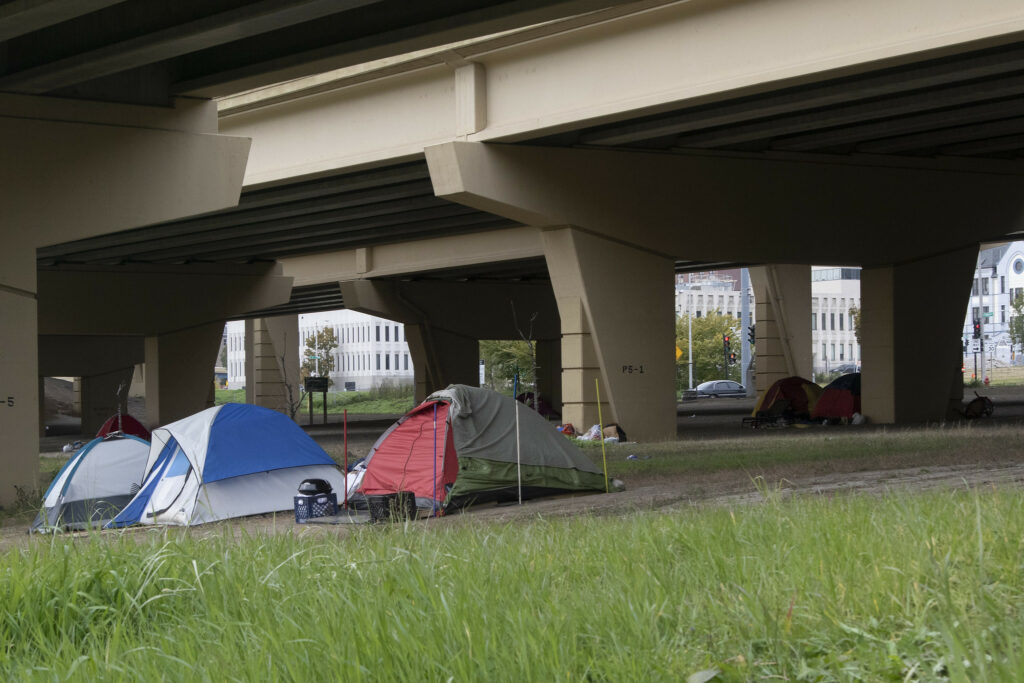Annual Homeless Population Count Reveals Difficulties In Finding People Shelter
Federal rules require count to be done in January, with results determining future resource allocation.

A homeless encampment located on North 6th Street between West Michigan Street and West St. Paul Avenue in 2018. (NNS file photo by Max Nawara)
Temperatures were below freezing throughout the night, and it snowed off and on.
Around 10:30 p.m. Jan. 25, eight teams, totaling 23 people, piled into vehicles and exited the parking lot of the Housing Division of the Milwaukee County Department of Health & Human Services.
The reason for the late night: to count how many people who were:
Living outside.
Unsheltered.
In tents.
At bus stops.
Under bridges.
It was the night of the annual Point-in-Time Count, a night where people experiencing homelessness are counted.
“This may very well be my favorite night of the year just because it is such a huge opportunity to have everybody out at one time and be able to cover every area,” said Beth Lappen, downtown outreach coordinator with the Housing Division.
In Milwaukee, the count is planned and executed by the Milwaukee Continuum of Care, or CoC. The CoC’s members include both the city and county as well as 100 other organizations that provide housing services.
The annual Point-in-Time count produces aggregated data that supports CoC planning efforts and is used as evidence to gain additional funding for homeless services from the U.S. Department of Housing and Urban Development, or HUD; the State of Wisconsin; and other sources of private funding.
Why it matters
The U.S. Department of Housing and Urban Development mandates the count be done every year, on the fourth Wednesday of January.
The count is used to help determine the ratio between need and supply of housing resources, said Nancy Esteves, the homeless management information systems manager for the Institute for Community Alliances, a nonprofit based out of Des Moines, Iowa, that helps manage data for the CoC. Providing this data is one of the conditions of receiving federal funding for housing and homelessness-related programs.
Milwaukee County receives about $11 million a year of this funding, Esteves said.
In 2021, the city received national recognition for seeing an extreme decrease in unsheltered people sleeping outside. The count of 17 people — a 70-percent decrease from the previous year — was the result of expanded street outreach, the use of funds from the Coronavirus Aid, Relief, and Economic Security, or CARES, Act; efforts to reduce evictions; emergency hotel placements; and allowing Clare Hall on the Saint Francis de Sales Seminary grounds to be used for temporary shelter.
Eric Collins-Dyke, the assistant administrator of supportive housing and homeless services at the Housing Division, said the count “gives more of a clearer picture of the true nature of the issue over a yearlong span.”
Counting the people
Collins-Dyke and his van colleagues that night were tasked with counting people on the southeast portion of the city and surrounding suburbs, including Oak Creek. In the van with him were Shelly Sarasin and Nick Tomaro.
Sarasin is the co-founder of Street Angels Milwaukee Outreach, which helps people experiencing homelessness and provides them with food and basic hygiene items. Tomaro is the emergency preparedness environmental health director for the City of Milwaukee Health Department.
“It’s space that we started to get involved with during the pandemic and now are just kind of expanding that involvement,” Tomaro said. “Homelessness is a public health crisis. … I think it’s very important that health departments are involved in this work.”
“When you look at unsheltered homelessness, it’s an emergency in the sense that you’ve got a lot of very vulnerable people exposed to extreme elements outside.”
About halfway through the night, the three walked under a bridge at West Kinnickinnic River Parkway and South 31st Street and encountered four people: a man and woman who identified as a couple and two male friends who said they have known each other for many years.
They all asked for food, and the couple asked for sleeping bags.
About a week after the count, Collins-Dyke discussed the night.
“They’ve had a long history on the street,” he said. “They’ve all been on and off the street, in various housing programs, struggled with using consistently and, you know, have tried really, really, really hard to stay healthy and address those things from a harm-reduction standpoint, with the support of the outreach teams.”
All four were able to get a hotel room within 24 hours with the help of the Housing Division.
A lot of it, Collins-Dyke said, was a matter of luck.
“I’m really glad we connected with them because of how cold it got those next few days. They were just ready to go. It was sort of like perfect timing,” he said.
Not only does a bed inside meet obvious immediate needs, it also helps outreach workers know where to find their clients, Collins-Dyke said.
“It’s helpful to know that they’re in one spot consistently and have a tiny bit more stability to be able to have those conversations longer term,” he said. “They have a lot of things they have to do during the day to survive, like getting food, potentially showering, getting to appointments. So, now we know where they are all the time.”
The goal for service providers at this stage is to pursue long-term housing and other needed services with the person, such as medical care, mental health services and substance abuse treatment.
Sarasin and Tomaro both said there’s one specific obstacle that has not adequately addressed by the CoC: people with pets.
“It is one of the biggest barriers to shelter and housing,” said Sarasin. Pets are like people’s family on the street, she said, and “we would never ask families to separate. Why should we make people who have pets separate?”
Tomaro, a former veterinarian, said he helped advocate for people to be able to bring their pets into a warming room with them this year – “the first year that’s ever happened,” said Sarasin. “It has resulted in a lot of people not having to sleep outside because of that barrier. That’s important.”
Tomaro said during the count he encountered a man with four dogs that night as well as someone with three cats.
In addition to people with pets, Tomaro said he also noticed people sleeping in their cars.
“I don’t think that’s always acknowledged,” he said. “It’s a little bit more difficult for people to kind of visualize sometimes.”
What’s next?
Altogether, the outreach teams visited close to 200 different sites throughout the night, said Collins-Dyke. In the southeast region alone, 19 people were counted, more than the total numbers for both 2021 and 2022.
Collins-Dyke attributes several factors to the jump, including a warmer-than-normal winter, “a stagnancy of housing resources” and insufficient numbers of housing navigators, staff who are specifically tasked with helping a person go through the lengthy and bureaucratic process of applying and qualifying for housing.
The official numbers of the count will be released in March by the U.S. Department of Housing and Urban Development.
All three providers were appreciative of each other’s work and recognized that all of the gaps and shortcomings in the system can only be overcome through collaboration.
“Our trio and collaboration – county, city and nonprofit – showed how well we can work when we break down the silos,” Sarasin said. “The three of us have been intent with each other on doing so.”
Here’s how you can help
You can support the organizations that make up the CoC. These organizations include Community Advocates, Guest House of Milwaukee, Hope House, Outreach Community Health Centers and many more agencies.
The Continuum of Care seeks volunteers yearlong. You can keep tabs of the organization on its Facebook page.
If you need housing assistance, you can seek help through rent assistance programs being administered by Community Advocates and the Social Development Commission. You could reach out to the Milwaukee Rental Housing Resource Center, or RHRC, for other housing issues. Officials can be contacted at info@renthelpmke.org or 414-895-RENT.
We spent a below-freezing night with officials counting those who are homeless. Here’s what we saw. was originally published by Milwaukee Neighborhood News Service





















